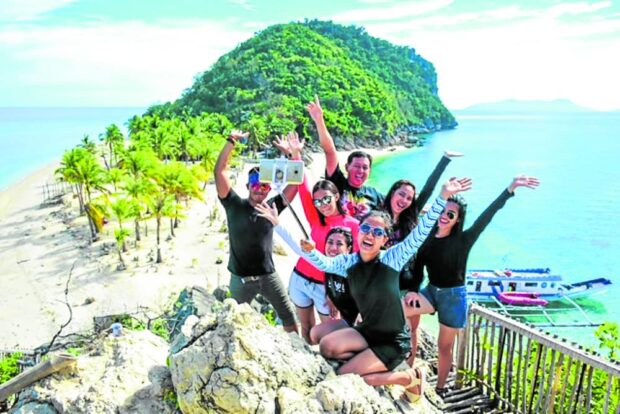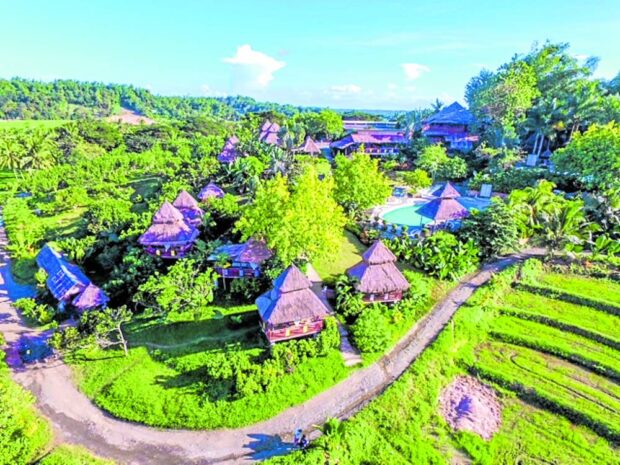
The Damires Hills Tierra Verde Leisure Farm in Janiuay, Iloilo, never fails to put a smile on visitors’ faces. —Gerard Villareal
ILOILO CITY—Iloilo is a tourism destination that promises an unforgettable journey through its captivating landscapes, cultural wonders and historic treasures, not to mention its culinary gems and the warm hospitality of its people.
Whether you’re a nature lover, a culture buff, a history enthusiast, a culinary adventurer, or a seeker of tranquility, Iloilo guarantees scenery and vistas, stories and tales, as well as sweetness and charm.
Tourists will also discover there is more to the travel slogans—“Where the past is always present” or “Food, Foodie, Friendly”—once they reach the cool pine forest of the Bucari mountain range, the depths of the Bulabog-Putian caves, or the shores of Cabugao Gamay Island.
Tourists flock to Iloilo City mostly during the fourth weekend of January when it celebrates the Dinagyang Festival, a vibrant and captivating celebration that fuses religious devotion, cultural heritage and energetic performances into an electrifying event.
Visitors usually extend their stay until Feb. 2 for the feast of the Nuestra Señora de la Candelaria, patron saint of the district of Jaro, a city during the Spanish era that has retained its distinct character being home to prominent and influential families known for their contributions to various fields such as business, politics, and culture.
Year-round attractions
During the rest of the year, attractions in the province draw tourists – the stunning natural landscapes, the beautiful centuries-old churches, and the opportunity to immerse in the rich culture and way of life of the Ilonggos through their art, their tradition and their food.
Many bikers head to the hilly towns where barangay roads and carabao trails offer challenging yet exhilarating adventure that promises breathtaking views and a sense of accomplishment.
They would even brave the ascending and winding roads to the highlands of Barangay Bucari in the central town of Leon, or to the peak of Barangay Igtuble in the southern town of Tubungan, or to hillsides of Baklayan in the northern town of San Rafael, all of which offer a magnificent view of the surrounding mountains, valleys, and forests.

The pool and nature-inspired amenities keep guests flocking to the Damires Hills Tierra Verde Leisure Farm in Janiuay, Iloilo.
These same destinations are also magnets to families, group of friends, or college cliques who wish to have a brief respite from the noise, the heat and the congestion of the urban environment, and enjoy the clean, crisp and cool mountain air for a day, not to mention the local eateries offering delicious meals and snacks.
The more popular one is Bucari, also known as the “Little Baguio of Iloilo,” for its cool climate, highland attractions and towering pine trees in Sitio Tabionan that were planted during the early years of the American colonization where a campsite can now be found.
An hour hike from Tabionan is Imoy waterfalls which offers a refreshing retreat for nature lovers, who may want to embrace the cascading waters or take a dip or dive into its two-meter-deep natural pool.
Mt. Agua Colognia, Bucari’s highest peak at 1,200 meters above sea level, dares the more adventurous ones to conquer its height.
Those who wish to spend a night in the campsite, which has communal toilets and showers built by the local government of Leon, can rent a tent from residents in the area. They can also rent a cottage at the Bucari National High School which is a kilometer away, or book a room at the Pineridge Bucari Mountain Resort which is about 2 km down the camp.
Another attraction is the magnificent views of Barangay Igtuble in Tubungan in the south and of Sitio Baklayan, Barangay Aripdip in San Rafael in the north.
The spectacular sight from the peak of Igtuble came to people’s attention after an inter-provincial boundary 6-km road network connecting the town of Tubungan in Iloilo and the town of San Remigio in Antique was started in 2021. Drone photos of the project became viral on social media and everyone wanted to experience the view from the top.
Although the Barotac Viejo-San Rafael bypass road, which passes through Barangay Aripdip, was built much earlier than the Tubungan-San Remigio road, the scenery from Sitio Baklayan was appreciated only lately when eateries and coffee shops began to mushroom along the highway, encouraging motorists to stop for a quick meal or snack.
Pristine beaches
The easing of pandemic restrictions brought back tourists to other destinations like the Gigantes and Cabugao Gamay islands off the northern town of Carles, the Bulabog-Putian National Park in the north-central town of Dingle, and the reopened ecotourism sites like the Damires Hills in the central town of Janiuay, the Garin Farm in the southern town of San Joaquin, and the Sol y Mar Eco Farm in the southern town of Tigbauan.
The Gigantes group of islands — consisting of Gigantes Sur, Gigantes Norte and seven other islets — is often associated with pre-Hispanic pottery following the discovery of a burial jar in the 1970s on the shores of Gigantes Sur that resulted in wave of systematic treasure hunting activities there, the biggest of which was possibly in 1997.
A drone photo of the pool and the facilities at the Damires Hills Tierra Verde Leisure Farm in Janiuay, Iloilo. —photos by Gerard Villareal
But it is its beaches that continue to attract people to the area, especially the two limestone hills and the sandbar that separates them and comprise Cabugao Gamay Island. On both sides of the sandbar are crescent-shaped powdery white sand beaches that contrast beautifully with the vibrant turquoise waters of the surrounding sea.
Gigantes Norte, for its part, is home to an 18-meter-tall Spanish lighthouse that was completed in 1895. A museum was opened at the original keeper’s house in 2016, while a room was turned into a coffee shop that is now run by an association of mothers on the island.
Built of coral stones, bricks and hardwood, the keeper’s house used to be a complete dwelling facility with basic furnishings like beds, tables, chairs and a kitchen.
Communing with nature
The 854-hectare Bulabog-Putian National Park, a protected area since 1961 by virtue of Presidential Proclamation No. 760, is a haven for biologists, archaeologists and spelunkers. Consisting of 30 cave systems, it supports diverse species of flora and fauna, and has been the hideout of revolutionaries during the Spanish period, and of guerillas during World War II.
Tourists come to the park to explore and enjoy the landscape and learn about the wildlife in the area.
For those who wish to commune with nature but require en-suite accommodation, there are other ecotourism sites in Iloilo that offer such facilities.
The Damires Hills is a nature and adventure park known for its picturesque landscape, featuring rolling hills, lush greenery, and scenic views.
A drone photo of the winding road in Barangay Igtuble in Tubungan, Iloilo.—photo by Gerard Villareal
Visitors can enjoy a variety of activities such as ziplining, trekking, horseback riding, and swimming in the pool.
The Garin Farm is an agritourism destination that combines agriculture, leisure, and spirituality. One of its most iconic features is the “Stairway to Heaven,” a series of steep steps leading to a hilltop cross.
The farm also offers guided tours where visitors can learn about various agricultural practices, including rice planting, animal husbandry, and organic farming.
It provides a unique blend of recreation, education, and reflection.
There are other destinations in Iloilo worth exploring — from its awe-inspiring mountain views to its pristine beaches.
Its commitment to sustainable tourism and rich cultural tapestry make every visit not only a personal journey but also a contribution to the preservation of its precious gems. INQ

